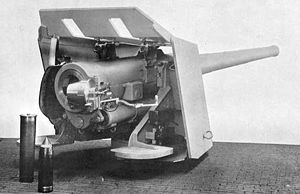QF 6 inch Mk I - III naval gun
| QF 6 inch 40 calibre naval gun Type 41 6-inch (152 mm)/40-caliber |
|
|---|---|

Typical naval deck mounting. An early long cartridge case for gunpowder propellant is upended at bottom left, a shell stands next to the cartridge.
|
|
| Type |
Naval gun Coast defence gun |
| Place of origin |
United Kingdom license-produced in Japan |
| Service history | |
| In service | 1892–1945 |
| Used by |
Royal Navy Imperial Japanese Navy Chilean Navy Italy Navy Argentine Navy United States Romanian Navy |
| Wars |
Russo-Japanese War World War I World War II |
| Production history | |
| Manufacturer |
Elswick Ordnance Company Royal Arsenal, Woolwich |
| Specifications | |
| Weight | 6.6 tons |
| Barrel length | 240 inches (6.096 m) bore |
|
|
|
| Shell | 100 pounds (45 kg) QF, separate cartridge and shell |
| Calibre | 6 inches (152.4 mm) |
| Elevation | -5 / +20 degrees |
| Traverse | +150 / -150 degrees |
| Rate of fire | 5-7 rounds per minute |
| Muzzle velocity | 2,154 feet per second (657 m/s) 820 feet per second (250 m/s) for anti-submarine shells |
| Effective firing range | 10,000 yards (9,140 m) at 20°elevation; 15,000 yards (13,700 m) at 28°elevation |
The QF 6 inch 40 calibre naval gun (Quick-Firing) was used by many United Kingdom-built warships around the end of the 19th century and start of the 20th century.
In UK service it was known as the QF 6 inch Mk I, II, III guns. As the Type 41 6-inch (152 mm)/40-caliber naval gun it was used for pre-dreadnought battleships and armoured cruisers of the early Imperial Japanese Navy built in UK and in European shipyards.
These guns were developed to exploit the new "QF" technology, which involved loading the propellant charge in a brass case with primer in its base. The brass case also sealed the breech, allowing a lighter mechanism. This was presumed to allow a faster rate of fire than the older "Breech Loading" system, where the propellant was loaded in cloth bags and then a separate friction or percussion tube fitted into the breech for firing. The QF principle had proved successful with the much smaller QF 3 pounder Hotchkiss and Nordenfelt QF 3 and 6 pounders from 1885 onwards.
The Mk I was an Elswick gun of built up construction. Mk II was built by Woolwich Arsenal and in 1891 became the first Royal Navy gun using the Armstrong wire-wound construction. The breech mechanisms were developed from the existing 6-inch (150 mm) BL mechanisms, but as it no longer had to provide obturation (sealing of the breech), the front was made coned rather than straight which allowed it to be swung round to the side before it was fully withdrawn, rather than having to be fully withdrawn before swinging to the side as with the BL gun.
The preceding generation of British 6-inch guns (BL Mks III, IV and VI) had old-style trunnions by which they were mounted on Vavasseur inclined slides to absorb recoil. QF Mk I and II dispensed with trunnions and instead on the lower side of the breech ring were lugs to which were attached modern recoil buffer and hydrospring recuperator (runout) cylinders to absorb recoil and return the barrel to loading position after firing. This allowed the gun to recoil directly backwards rather that backwards and upwards as previously, and is the recoil system which in essence is still in use.
...
Wikipedia
